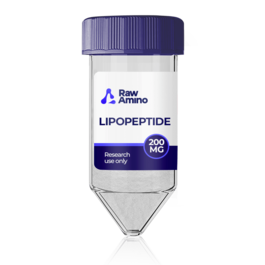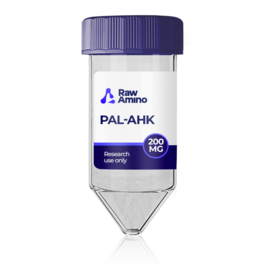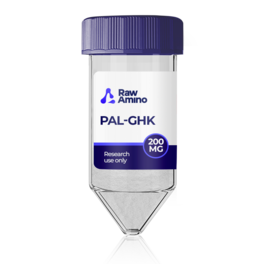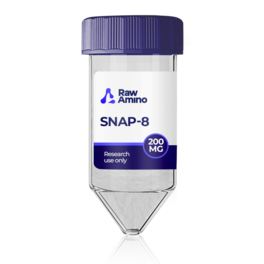
AHK-Cu – 200MG
$184.00
Discount per Quantity
| Quantity | Discount | Price |
|---|---|---|
| 5 - 8 | 5% | $174.80 |
| 9 + | 10% | $165.60 |
Out of stock
Scientific Overview of AHK-Cu
AHK-Cu is a small copper-binding tripeptide composed of alanine, histidine, and lysine. The copper atom is bound within the structure through nitrogen interactions, and the compound is found naturally in biological systems. Research has suggested that AHK-Cu may participate in cellular signaling and regulation processes, with particular interest in vascular endothelial cells and fibroblasts. These roles are thought to be linked to its influence on signaling pathways such as those involving Vascular Endothelial Growth Factor (VEGF) and Transforming Growth Factor beta (TGF-β).
AHK-Cu Studies and Research Data
Research on Angiogenesis and Vascular Growth
Scientific investigations indicate that AHK-Cu may play a role in modulating angiogenic processes. VEGF, a signaling protein often released by oxygen-deprived cells, is considered important in the initiation of new blood vessel formation. Studies suggest that the VEGF/VEGFR-2 pathway may be particularly relevant, as its activation seems to trigger intracellular signaling cascades that potentially influence endothelial cell migration, proliferation, and survival. AHK-Cu has been studied in this context for its possible contribution to enhancing VEGF signaling, which may in turn support fibroblast and endothelial cell activity.
AHK-Cu Investigations into Skin Cell Research
Collagen production in skin cells tends to decline with age, leading to structural weakening and decreased elasticity. Laboratory experiments with fibroblasts have suggested that AHK-Cu may contribute to processes involved in collagen formation. In some in-vitro studies, fibroblast cultures exposed to AHK-Cu complexes appeared to show an increase in collagen type I production, with reports of increases as high as 300% over controls. This points to the possibility that the peptide could influence extracellular matrix maintenance, hydration, and skin barrier strength in laboratory settings.
Potential Links to Hair Follicle Biology
Research has also examined the peptide in relation to dermal papilla cells (DPCs), specialized fibroblasts implicated in hair follicle development. Some studies hypothesize that AHK-Cu may promote follicle growth by supporting blood vessel formation around follicles and by modulating apoptosis-related pathways in DPCs. Experimental data suggest a possible reduction in apoptotic signaling proteins and an increase in survival-related markers, hinting at a protective or growth-supportive role in cultured cells. Additionally, researchers have speculated that AHK-Cu might influence the transition and duration of hair growth phases, particularly the anagen stage, although further confirmation is needed.
Conclusion
AHK-Cu has been the focus of several laboratory studies exploring its potential to modulate collagen synthesis, angiogenesis, and hair follicle biology. Research suggests that its activity may be linked to VEGF and TGF-β signaling, fibroblast activation, and endothelial function. While results are preliminary and limited to experimental systems, the findings highlight possible pathways through which AHK-Cu may interact with cellular processes.
References
- Pyo HK, Yoo HG, Won CH, Lee SH, Kang YJ, Eun HC, Cho KH, Kim KH. The effect of tripeptide-copper complex on human hair growth in vitro. Arch Pharm Res. 2007 Jul;30(7):834-9. doi: 10.1007/BF02978833. PMID: 17703734.https://doi.org/10.1007/BF02978833
- Ferrari G, Cook BD, Terushkin V, Pintucci G, Mignatti P. Transforming growth factor-beta 1 (TGF-beta1) induces angiogenesis through vascular endothelial growth factor (VEGF)-mediated apoptosis. J Cell Physiol. 2009 May;219(2):449-58. doi: 10.1002/jcp.21706. PMID: 19180561; PMCID: PMC2749291.https://doi.org/10.1002/jcp.21706
- Patt, Leonard M., and A. Procyte. ""Neova® DNA Repair Factor Nourishing Lotion Stimulates Collagen and Speeds Natural Repair Process."" skin 1 (2009): 2.
Disclaimer:
The products mentioned are intended solely for laboratory research and in-vitro experimentation. They are not approved for human or animal use of any kind. All details provided are for educational purposes only. By purchasing from this site, you agree to comply with our Terms and Conditions.
12 reviews for AHK-Cu – 200MG
Only logged in customers may leave a review.




Patrick C –
Reliable, always, always
benjamin poole –
Always satisfied with orders from here.
shelby peterson –
batch looked clean and sealed securely.
Jonathan S –
johnson thomas –
I accidently ordered the wrong thing. As soon as RA received my email, they contacted me and resolved my problem within a single week. They seem to have a knack for finding solutions to complex issues. I’ve had to wait weeks or months to hear back from other sites when I’ve made purchases there.
Donald H –
Excellent product presentation and quality. Can someone please answer if they sell bac water separately or only with large orders?
jeremy M –
Katherine H –
I really like Raw I feel like I have been using other sites and they always have SOME issues like credit card processing or crazy prices or not that helpful CS but I feel supported here. This is my first time ordering AHK-CU but over time I’ve built trust with this company, I know theyre solid. Get off the fence.
rogers dawn –
Do we have topical?
alison guzman –
Eric H –
Jason U –